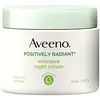What's inside
What's inside
 Key Ingredients
Key Ingredients

 Benefits
Benefits

 Concerns
Concerns

 Ingredients Side-by-side
Ingredients Side-by-side

Water
Skin ConditioningGlycerin
HumectantNiacinamide
SmoothingDimethicone
EmollientAvena Sativa Kernel Flour
AbrasiveVaccinium Macrocarpon Fruit Extract
AstringentCetearyl Olivate
Sorbitan Olivate
EmulsifyingCaprylyl Glycol
EmollientDimethiconol
EmollientDimethicone Crosspolymer
Emulsion StabilisingC13-14 Isoparaffin
EmollientLaureth-7
EmulsifyingSodium Polyacrylate
AbsorbentPolyacrylamide
Chlorphenesin
AntimicrobialCitric Acid
BufferingWater
Skin ConditioningOctyldodecyl Neopentanoate
EmollientDicaprylyl Carbonate
EmollientGlycerin
HumectantBehenyl Alcohol
EmollientGlycine Soja Seed Extract
Skin ConditioningMangifera Indica Seed Butter
Skin ConditioningGlyceryl Stearate
EmollientCandelilla/Jojoba/Rice Bran Polyglyceryl-3 Esters
EmulsifyingVinyl Dimethicone/Methicone Silsesquioxane Crosspolymer
Potassium Cetyl Phosphate
EmulsifyingNiacinamide
SmoothingPhenoxyethanol
PreservativeSodium Stearoyl Lactylate
EmulsifyingCetearyl Alcohol
EmollientMicrocrystalline Cellulose
AbsorbentCaprylyl Glycol
EmollientParfum
MaskingMagnesium Aluminum Silicate
AbsorbentChlorphenesin
AntimicrobialCetyl Hydroxyethylcellulose
Emulsion StabilisingDisodium EDTA
Tocopheryl Acetate
AntioxidantSodium PCA
HumectantUrea
BufferingEthylhexylglycerin
Skin ConditioningCellulose Gum
Emulsion StabilisingGlyceryl Acrylate/Acrylic Acid Copolymer
HumectantTrehalose
HumectantHexylene Glycol
EmulsifyingPolyquaternium-51
Skin ConditioningTriacetin
AntimicrobialSodium Hyaluronate
HumectantTitanium Dioxide
Cosmetic ColorantWater, Octyldodecyl Neopentanoate, Dicaprylyl Carbonate, Glycerin, Behenyl Alcohol, Glycine Soja Seed Extract, Mangifera Indica Seed Butter, Glyceryl Stearate, Candelilla/Jojoba/Rice Bran Polyglyceryl-3 Esters, Vinyl Dimethicone/Methicone Silsesquioxane Crosspolymer, Potassium Cetyl Phosphate, Niacinamide, Phenoxyethanol, Sodium Stearoyl Lactylate, Cetearyl Alcohol, Microcrystalline Cellulose, Caprylyl Glycol, Parfum, Magnesium Aluminum Silicate, Chlorphenesin, Cetyl Hydroxyethylcellulose, Disodium EDTA, Tocopheryl Acetate, Sodium PCA, Urea, Ethylhexylglycerin, Cellulose Gum, Glyceryl Acrylate/Acrylic Acid Copolymer, Trehalose, Hexylene Glycol, Polyquaternium-51, Triacetin, Sodium Hyaluronate, Titanium Dioxide
Ingredients Explained
These ingredients are found in both products.
Ingredients higher up in an ingredient list are typically present in a larger amount.
Caprylyl Glycol is a humectant and emollient, meaning it attracts and preserves moisture.
It is a common ingredient in many products, especially those designed to hydrate skin. The primary benefits are retaining moisture, skin softening, and promoting a healthy skin barrier.
Though Caprylyl Glycol is an alcohol derived from fatty acids, it is not the kind that can dry out skin.
This ingredient is also used as a preservative to extend the life of products. It has slight antimicrobial properties.
Learn more about Caprylyl GlycolChlorphenesin is a synthetic preservative. It helps protect a product against bacteria in order to extend shelf life. In most cases, Chlorphenesin is paired with other preservatives such as phenoxyethanol and caprylyl glycol.
Chlorphenesin is a biocide. This means it is able to help fight the microorganisms on our skin. It is also able to fight odor-releasing bacteria.
Chlorphenesin is soluble in both water and glycerin.
Studies show Chlorphenesin is easily absorbed by our skin. You should speak with a skincare professional if you have concerns about using Chlorphenesin.
Learn more about ChlorphenesinGlycerin is already naturally found in your skin. It helps moisturize and protect your skin.
A study from 2016 found glycerin to be more effective as a humectant than AHAs and hyaluronic acid.
As a humectant, it helps the skin stay hydrated by pulling moisture to your skin. The low molecular weight of glycerin allows it to pull moisture into the deeper layers of your skin.
Hydrated skin improves your skin barrier; Your skin barrier helps protect against irritants and bacteria.
Glycerin has also been found to have antimicrobial and antiviral properties. Due to these properties, glycerin is often used in wound and burn treatments.
In cosmetics, glycerin is usually derived from plants such as soybean or palm. However, it can also be sourced from animals, such as tallow or animal fat.
This ingredient is organic, colorless, odorless, and non-toxic.
Glycerin is the name for this ingredient in American English. British English uses Glycerol/Glycerine.
Learn more about GlycerinNiacinamide is a multitasking form of vitamin B3 that strengthens the skin barrier, reduces pores and dark spots, regulates oil, and improves signs of aging.
And the best part? It's gentle and well-tolerated by most skin types, including sensitive and reactive skin.
You might have heard of "niacin flush", or the reddening of skin that causes itchiness. Niacinamide has not been found to cause this.
In very rare cases, some individuals may not be able to tolerate niacinamide at all or experience an allergic reaction to it.
If you are experiencing flaking, irritation, and dryness with this ingredient, be sure to double check all your products as this ingredient can be found in all categories of skincare.
When incorporating niacinamide into your routine, look out for concentration amounts. Typically, 5% niacinamide provides benefits such as fading dark spots. However, if you have sensitive skin, it is better to begin with a smaller concentration.
When you apply niacinamide to your skin, your body converts it into nicotinamide adenine dinucleotide (NAD). NAD is an essential coenzyme that is already found in your cells as "fuel" and powers countless biological processes.
In your skin, NAD helps repair cell damage, produce new healthy cells, support collagen production, strengthen the skin barrier, and fight environmental stressors (like UV and pollution).
Our natural NAD levels start to decline with age, leading to slower skin repair, visible aging, and a weaker skin barrier. By providing your skin niacinamide, you're recharging your skin's NAD levels. This leads to stronger, healthier, and younger looking skin.
Another name for vitamin B3 is nicotinamide. This vitamin is water-soluble and our bodies don't store it. We obtain Vitamin B3 from either food or skincare. Meat, fish, wheat, yeast, and leafy greens contain vitamin B3.
The type of niacinamide used in skincare is synthetically created.
Learn more about NiacinamideWater. It's the most common cosmetic ingredient of all. You'll usually see it at the top of ingredient lists, meaning that it makes up the largest part of the product.
So why is it so popular? Water most often acts as a solvent - this means that it helps dissolve other ingredients into the formulation.
You'll also recognize water as that liquid we all need to stay alive. If you see this, drink a glass of water. Stay hydrated!
Learn more about Water